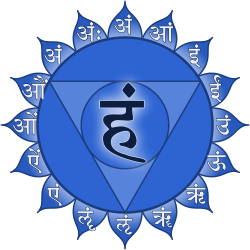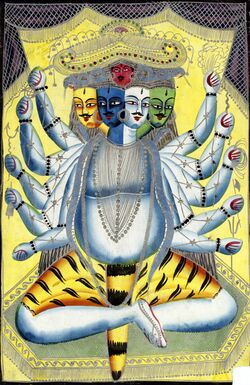Philosophy:Vishuddha
Vishuddha (Sanskrit: विशुद्ध, IAST: Viśuddha, English: "especially pure"), or Vishuddhi (Sanskrit: विशुद्धी), or throat chakra is the fifth primary chakra according to the Hindu tradition of tantra.[1] The residing deity of this chakra is Panchavaktra shiva, with 5 heads and 4 arms, and the Shakti is Shakini.
Description
Location
Vishuddha is positioned at the throat region, near the spine, with its Kshetram or superficial activation point in the pit of the throat. Due to its position, it is known as the throat Chakra.[citation needed]
Appearance
According to Hindu tradition, this chakra is described as having a "white color" with sixteen "purple" or "smoke-colored petals." Within the pericarp is a sky-blue downward pointing triangle containing a circular white region like the full moon. This represents the element of akasha or "aether." This region is represented by the deity Ambara, who is also white in color and is depicted with four arms, holding a noose and a goad. He makes the gestures of granting boons and dispelling fear while seated upon a white elephant. The silver crescent is the lunar symbol of nada, pure cosmic sound. The crescent is symbolic of purity, and purification is a vital aspect of Vishuddha Chakra.[2]
Seed syllable
The Bija Mantra is the syllable हं haṃ, and is written in white upon the chakra. In the Bindu, or point above the mantra, resides the deity Sadashiva, who has 5 faces, representing the spectrum of smell, taste, sight, touch, and sound and 10 arms. The right half of his body is a white Shiva, and the left half of the body is a golden Shakti. He is holding a trident, chisel, sword, vajra, fire, a great snake, a bell, a goad, and a noose, and is making the gesture of dissipating fear. He is clad in a tiger skin. His Shakti is Shakini, who is shining white, seated on a red lotus, and with five faces, three eyes each, and four-armed, with a bow and arrow, noose, and goad.
Petals
Vishuddha has 16 purple petals upon which are written the 16 Sanskrit vowels in golden;
| अ a | आ ā | इ i | ई ī | उ u | ऊ ū | ऋ ṛ | ॠ ṝ |
| ऌ ḷ | ॡ ḹ | ए e | ऐ ai | ओ o | औ au | अः ḥ | अं ṃ |
NB: Some vowels listed above do not strictly correspond to the grammatical definition of a Sanskrit vowel, specifically ॡ ḹ, अः ḥ, and अं ṃ. See Sanskrit Phonology for details.
The petals correspond to the Vrittis of the mantra Ong [Aum], the Sama-mantras, the mantras Hung, Phat, Washat, Swadha, Swaha, and Namak, the nectar Amrita, and the seven musical tones.
Function
Vishuddha chakra is known as the purification center, where the nectar amrita drips down from the Bindu chakra and is split into a pure form and a poison. In its most abstract form, it is associated with higher discrimination and is associated with creativity and self-expression. It is believed that when Vishuddha is closed, a person undergoes decay and death. When it is open, negative experiences are transformed into wisdom and learning. The success and failure in one's life are said to depend upon the state of this chakra, whether it is polluted or clean. The feeling of being guilty is given as the most prominent reason for this chakra to block the Kundalini energy moving upwards. It is associated with the element Akasha, or Ether, and the sense of hearing, as well as the action of speaking.[citation needed]
Meditation upon this chakra is said to bring about various siddhis or occult powers: vision of the three periods, past, present and future; freedom from disease and old age; destruction of dangers; and the ability to move the three worlds.
Lalana chakra
Closely related to Vishuddha is a minor chakra, located in the roof of the mouth, called Lalana. It is described as having 16 red or white petals that correspond to the virtues of respect, contentment, offense, self-control, pride, affection, sorrow, depression, purity, dissatisfaction, honor and anxiety. Inside is a red circular moon region, which acts as a reservoir for the nectar Amrit. When Vishuddha is inactive, this nectar is allowed to run downwards into Manipura and consumed, resulting in physical degeneration. Through practices such as khechari mudra, however, the nectar can be made to enter Vishuddha, where it is purified, and becomes a nectar of immortality.
Associations with the body
This chakra is located in the neck and the throat. Due to its association with hearing, it is related to the ears, and due to its association with speaking, it is associated with the mouth.
Vishuddha is often associated with the thyroid gland in the human endocrine system. This gland is in the neck, and produces hormones essential for growth and maturation. Excessive stress, namely fear and fear from speaking out, are said to affect the throat chakra, and thyroid problems may occur. Singing is a harmless and beneficial way of stimulating the throat chakra, whereas rubbing or hitting the throat area is not and can be harmful.[3][better source needed]
Practices
In Kundalini yoga, Vishuddha can be opened and balanced through practices including asanas (such as shoulder-stand), pranayama, Jalandhara Bandha (throat lock), and Khecarī mudrā. This chakra can be cleaned or opened by meditation or vocalisation.
There are also special Meditations with Specific Influence on the Vishuddhi Chakra.[4]
See also
- Philosophy:Ahamkara – Sanskrit term in Saṃkhyā philosophy
- Dhyana in Hinduism – Term for contemplation and meditation
- Philosophy:Maitrī – One of the ten pāramīs of the Theravāda school of Buddhism
- Prajñā – Highest and purest form of wisdom, intelligence and understanding
- Samatva – Hindu concept of equanimity
References
- ↑ Varenne (1989), p. 169.
- ↑ Goswami (1999), pp. 279-80.
- ↑ Patrinos, Nya (2015-08-26). "Art/Yoga Fusion: Chakra Series - Yin Yoga for the Throat Chakra - Vishuddhi". http://nyapatrinos.blogspot.com/2015/08/chakra-series-yin-yoga-for-throat.html.
- ↑ Maheśvarānanda (2004), p. [page needed].
Works cited
- Goswami, Shyam Sundar (1999). Layayoga: The Definitive Guide to the Chakras and Kundalini. Inner Traditions/Bear. ISBN 978-0892817665.
- Maheśvarānanda, Swami (2004). The Hidden Powers in Humans: Chakras and Kundalinī. Austria: Ibera-Verlag - Europ. University Press. ISBN 978-3850521970. https://www.chakras.net/. Retrieved 2022-12-14.
- Varenne, Jean (1989). Yoga and the Hindu Tradition (1st Indian ed.). Delhi, India: Motilal Banarsidass. ISBN 8120805437.
Further reading
- D'Angelo, James (2012). Seed Sounds for Tuning the Chakras: Vowels, Consonants, and Syllables for Spiritual Transformation. Inner Traditions/Bear. ISBN 978-1594774607.
- Judith, Anodea (May 30, 2002). "Visuddha - The Throat Chakra". http://www.llewellynencyclopedia.com/article/256.
- Kaviraj, Gopinath (1923). System of Chakras according to Gorakshanatha. Princess of Wales Sarasvati Bhavan Series. II. https://shivashakti.com/gorchak. Retrieved 2022-12-14.
- Vishnudevananda , Swami (1988). The Complete Illustrated Book of Yoga.. Harmony/Rodale. ISBN 978-0517884317.
 |



